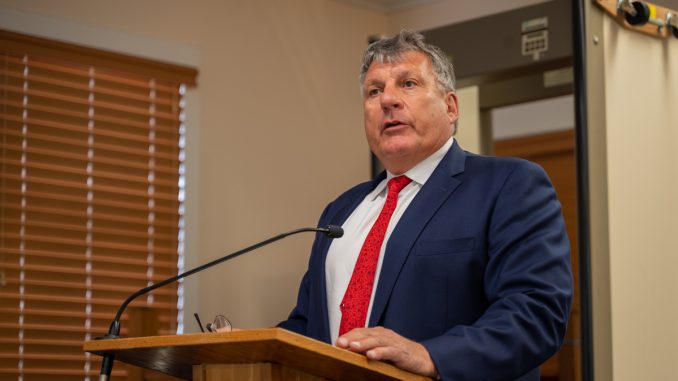
After 13 months of research and interviews, the BESS Task Force has submitted draft recommendations for regulating Battery Energy Storage Systems to the Southold Town Board.
BESS facilities store energy generated by renewable technologies, such as solar panels and wind turbines, for future consumption. The systems are currently not permitted under town code, but the technology could become a key component of the region’s energy supply. The Town Board recently renewed a moratorium on BESS applications through April 11, 2025.
The volunteer group — comprising seven area residents, including Norman Reilly of the Southold Town Fire Chief’s Council — examined the BESS codes of neighboring towns and interviewed local environmental advocates, town employees and elected officials to create its 39-page report, dated April 3. The group also met with representatives from the New York State Energy Research and Development Authority, which promotes energy efficiency and renewable energies, as well as developers and consultants involved in the installation of BESS facilities.
“I am thrilled that we have this volunteer group that was willing to work so hard on this,” Supervisor Al Krupski said in a telephone interview Tuesday.
Task Force recommendations state that any BESS facility with an energy capacity greater than 600kWh, which classifies it as Tier 2, would require a special use permit, a SEQRA Type I environmental impact statement and a site plan approval process that would examine an array of fire and other safety plans. The task force also recommends that Tier 2 facilities be allowed within certain nonresidential zoning districts. Among other restrictions, however, they could not be built within 150 feet of wetlands or on prime agricultural parcels, Community Preservation Fund properties, groundwater protection areas or scenic viewsheds. BESS facilities could only be built on lots of at least one acre, with storage units situated at least 750 feet from any occupied community building or critical environmental area.
For smaller Tier 1 BESS facilities, with energy capacity of 600kWh or less, the task force also recommends requiring permits and a SEQRA Type I environmental impact statement, but suggests an exemption from site plan review. Tier 1 facilities would be permitted in all zoning districts.
The framework of much of the report is derived from the NYSERDA Model Local Law, which many municipalities have used as a template for their BESS regulations. The Southold task force added language or bolstered requirements as it deemed necessary to protect the environment, ensure public safety and address quality of life concerns. The NYSERDA model, for instance, recommends applicants seeking approval for a BESS facility notify residents within 200 feet of their proposed site. The task force recommends amplifying this requirement tenfold, stating that applicants should notify property owners within 2,000 of their sites, and explaining that a metric “should exceed the fire departments’ evacuation zone should one be needed.”
Further addressing public safety, the task force recommends that applicants who receive approval be required to pay an impact fee for the “sole purpose of offsetting additional training and possible fire and safety equipment and apparatuses necessary for the installation and operation of a BESS system.” During the site plan approval process, the task force also recommends the town demand a hazard mitigation analysis and fire risk assessment, as well as commissioning an emergency operations plan.
BESS facility sites must be cleared of any trees and other combustible vegetation or growth by a minimum of 20 feet on all sides. To limit tree clearing and associated environmental impacts, the BESS Task Force suggests that BESS facilities be allowed only on lots that were cleared before 2018. The report outlines exceptions for the “removal of shrubs, underbrush and trees under six inches in diameter.”
Among many environmental concerns, members of Group for the East End and other advocates have championed preserving the night sky in recent years. The task force, which met with the group’s president, Bob Deluca, and Anne Murray, land use coordinator for the North Fork Environmental Council, addressed this quality of life concern in its report. The report states: “Lighting of the battery energy storage systems shall be limited to that minimally required for safety and operational purposes and shall be reasonably shielded and downcast from abutting properties.”
“The people from the environmental group, I thought that they were they were sensational,” said Michael Macco, a task force member. “We all live on the North Fork, because we like open space. We like the farmland, we like the vineyards, we like how we live. We’ve got to make sure that we preserve the agricultural land, especially the watershed. We certainly didn’t want to allow massive tree-cutting in certain areas that are wooded right now.”
With the task force’s mission complete, the Town Board and various town departments — including building, legal and planning — must now review its recommendations.
“It’s got to go through almost everyone,” Mr. Krupski explained. “We approved the extension of the moratorium so we would have time to do this. This is something we all have to take a close look at, figure out what part of the zoning it can go in and under what conditions. Then it has to go to the code committee. It’s a public document, so it will be a very public process … It also concerns public safety, so the local fire departments are going to be encouraged to weigh in also.”

